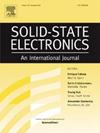硼薄膜准分子激光退火制备大面积低缺陷p+ Si区
IF 1.4
4区 物理与天体物理
Q3 ENGINEERING, ELECTRICAL & ELECTRONIC
引用次数: 0
摘要
采用化学气相沉积法在700℃下沉积硼层,并对其进行308 nm准分子激光退火(ELA)。非退火b沉积通常用于形成具有纳米级结深和低暗电流的辐射硬p+n PureB光电二极管,即PureB阳极区域具有高Gummel数。在这里,我们研究了一层厚度从单层到7 nm的b层沉积在低掺杂n-Si晶圆的氧化窗中,并实现了二极管与Al/1%Si互连层的接触。重点放在1纳米薄的b层上,在400至900 mJ/cm2的影响下进行ELA处理后,产生的理想二极管的阳极Gummel值至少与PureB等效二极管一样高。硅的熔化需要大于750 mJ/cm2的影响才能达到p区片材电阻<;100 Ω/sq。在熔体区,最大活性掺杂水平为2.3 × 1021个原子/cm3,在结深为85 nm、影响为900 mJ/cm2的情况下,薄片电阻为25 Ω/sq。在600 mJ/cm2时,在界面处约有一层B键与Si键合。这使得光电二极管在406 nm和670 nm波长处的最佳响应度分别为0.16 a /W和0.33 a /W。本文章由计算机程序翻译,如有差异,请以英文原文为准。
Excimer laser annealing of boron thin-films to fabricate large-area low-defect p+ Si regions
Boron layers deposited by chemical vapor deposition at 700 °C are exposed to 308 nm excimer laser annealing (ELA). The non-annealed B-deposition is commonly used to form radiation hard p+n PureB photodiodes that have nm-shallow junction depths with low dark currents, i.e., the PureB anode region has a high Gummel number. Here a B-layer thickness ranging from a monolayer to 7 nm was studied for deposition in oxide windows to lightly-doped n-Si wafers, and diode contacting was achieved with an Al/1%Si interconnect layer. The focus was placed on a 1-nm-thin B-layer that, after ELA at fluences from 400 to 900 mJ/cm2, delivered ideal diodes with anode Gummel numbers at least as high as PureB counterparts. Fluences above 750 mJ/cm2 were necessary for melting of the Si to achieve p-region sheet resistance <100 Ω/sq. The maximum active doping level was 2.3 × 1021 atoms/cm3 in the melt zone, providing a sheet resistance of 25 Ω/sq at a junction depth of 85 nm for a fluence of 900 mJ/cm2. At 600 mJ/cm2, about a monolayer of B bonded to Si at the interface remained. This rendered a photodiode with an optimal responsivity of 0.16 A/W at 406 nm and 0.33 A/W at 670 nm wavelengths.
求助全文
通过发布文献求助,成功后即可免费获取论文全文。
去求助
来源期刊

Solid-state Electronics
物理-工程:电子与电气
CiteScore
3.00
自引率
5.90%
发文量
212
审稿时长
3 months
期刊介绍:
It is the aim of this journal to bring together in one publication outstanding papers reporting new and original work in the following areas: (1) applications of solid-state physics and technology to electronics and optoelectronics, including theory and device design; (2) optical, electrical, morphological characterization techniques and parameter extraction of devices; (3) fabrication of semiconductor devices, and also device-related materials growth, measurement and evaluation; (4) the physics and modeling of submicron and nanoscale microelectronic and optoelectronic devices, including processing, measurement, and performance evaluation; (5) applications of numerical methods to the modeling and simulation of solid-state devices and processes; and (6) nanoscale electronic and optoelectronic devices, photovoltaics, sensors, and MEMS based on semiconductor and alternative electronic materials; (7) synthesis and electrooptical properties of materials for novel devices.
 求助内容:
求助内容: 应助结果提醒方式:
应助结果提醒方式:


